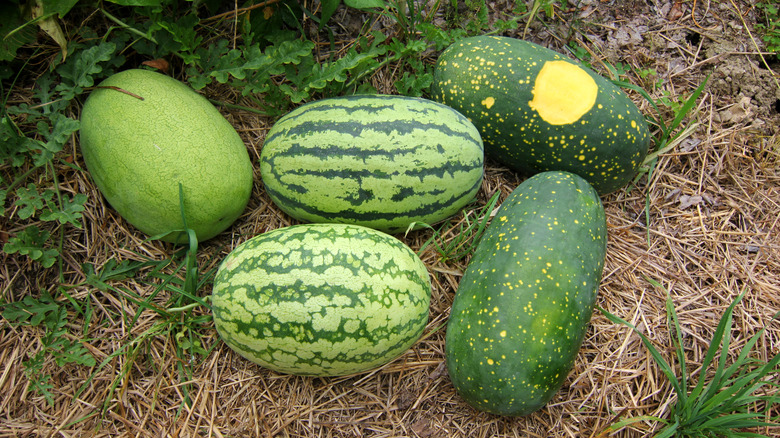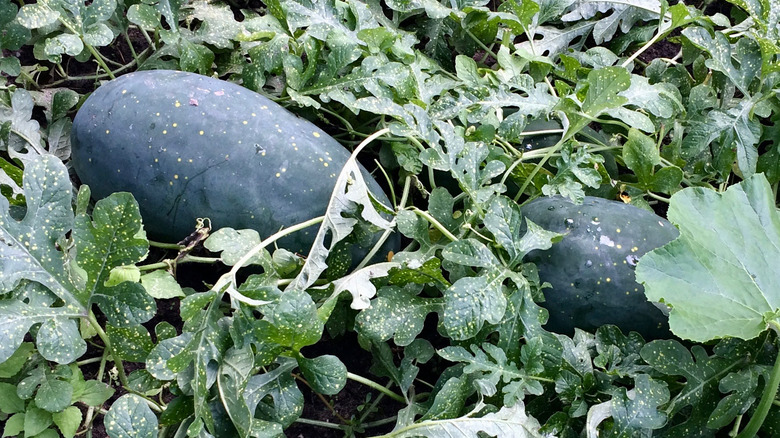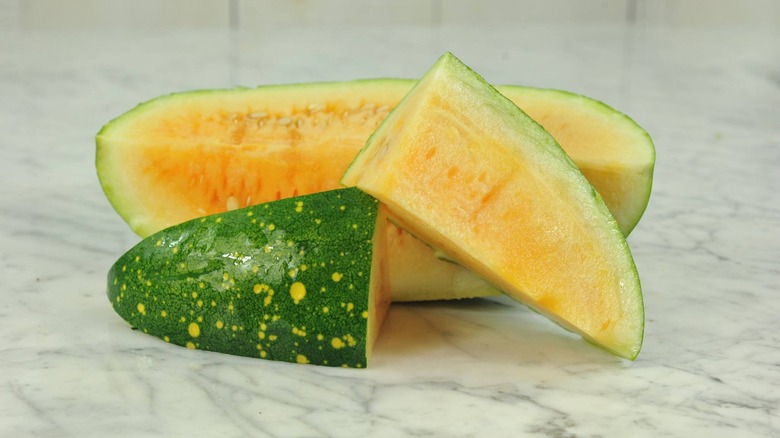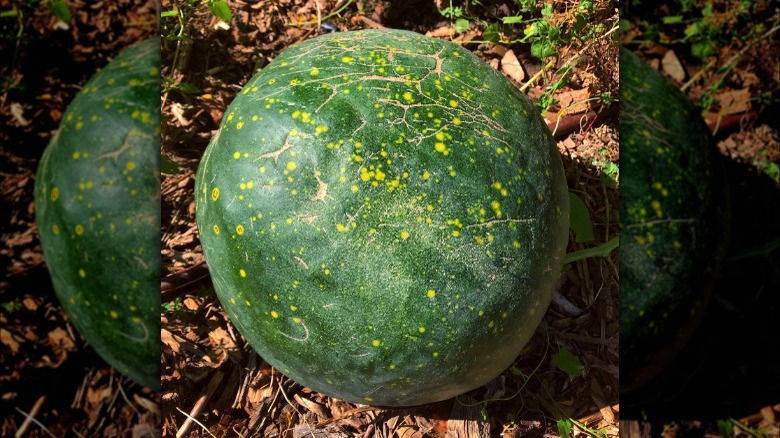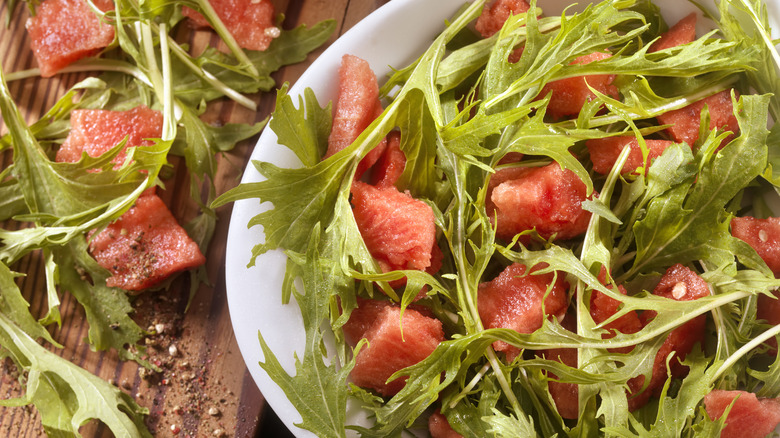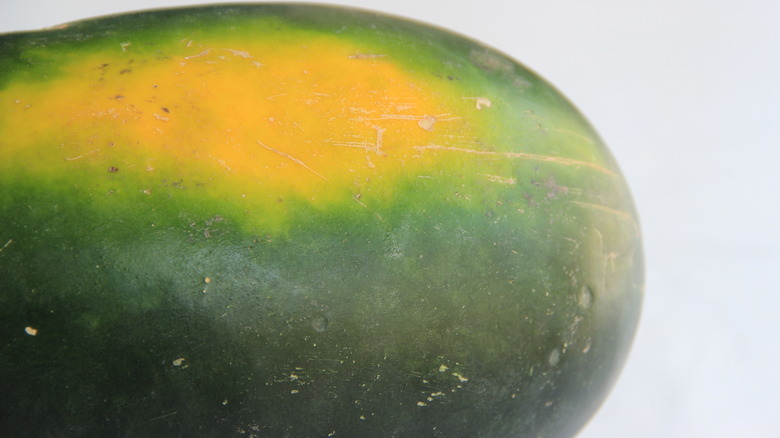The Rare Watermelon Variety That Looks Like A Sky Full Of Stars
Celestial objects get a lot of well-deserved attention, from stars to galaxies, orbiting planets, and the omnipresent glowing moon. But sometimes, facsimiles of those heavenly beauties show up in very earthly forms, including ones we put on our plates. In this case, we're talking juicy fresh watermelons eerily bearing astronomical imprints on their outer skins.
The rare heirloom watermelon variety is aptly called Moon and Stars, for exactly how it appears: a dark green rind dotted with yellow orb-ish spots. Some shapes are larger, resembling moons, while many smaller dots spray across the skin like twinkling stars.
It's a sight to behold — if you can find one. But don't despair if the elusive Moon and Stars melon universe doesn't shine in your part of the country; You can grow them yourself straight from the seeds.
What is a Moon and Stars watermelon?
Moon and Stars watermelons fall under the general Citrullus lanatus classification for watermelon fruits. They're members of the Cucurbitaceae plant family, which also includes various gourds, squashes, cucumbers, pumpkins, and other melons and watermelon varieties.
Moon and Stars watermelons can be round or oblong with varying interior colors, but the most common ones harbor vividly red flesh beneath the starry exterior. Average weights are up to 15 pounds, but these watermelons can get much larger. Some yellow-flesh ones weigh about 20 to 25 pounds, while other varieties can reach as much as 40 or 50 pounds.
They stand out not only for the otherworldly skin pattern but also for the inner seeds, which are abnormally large, brown, and numerous. Another artful attribute of this fruit is the leaves, which also string the playful star pattern throughout the fields or gardens in which the melons grow.
How to buy or grow a Moon and Stars watermelon
Count your lucky stars if you find a fully grown, ripe Moon and Stars watermelon for sale. Because of the size, weight, and rarity, it's hard to find them online or in local grocery stores or farmers markets. Most mere mortals will need to buy and grow the seeds at home or in community gardens.
Fortunately, many online gardening companies offer the heirloom Moon and Stars watermelon seeds, which will deliver fresh, juicy melons within about 95 to 100 days after planting at a depth of 1/2 inch, spaced 12 to 18 inches apart, in soil temperatures between 60 and 70 degrees Fahrenheit. They need full sun for at least six hours daily.
You don't need much space to accommodate this sweet extraterrestrial-looking melon. Thanks to a compact vine and relatively low weight, the Moon and Stars watermelon rests easily in most home garden spaces. Check the seed packet details to ensure you're buying a variety that matches the amount of space you can devote to this edible, nature-painted celestial display.
How to eat a Moon and Stars watermelon
If you do get your hands on a Moon and Stars watermelon, likely one you've grown yourself or been gifted by an avid gardener, feel free to dig right in. It tastes similar to other watermelons but is particularly super-sweet and juicy, especially in the red-skinned versions. Some people report that the flesh texture becomes "mealy" more quickly than other types of melons.
Because of the fairly large, abundant seeds, you'll have to do some preliminary seed extraction, especially if you want to make a watermelon smoothie, juice pops, slushies, or sorbets. The extra sweetness of Moon and Stars melons makes them shine in fruity cocktails, including sangria, margaritas, daiquiris, mojitos, or even non-alcoholic watermelon lemonade mocktails.
After some seed removal, the Moon and Stars watermelon flesh perks up salads, salsas, gazpacho soups, or watermelon cocktails. Like other watermelons, it pairs well with caprese or soft cheeses like feta. You can also pickle the rind or even sizzle it on the grill.
Nutritional information about Moon and Stars watermelons
A Moon and Stars watermelon carries similar nutrition benefits to other watermelons, notably its ability to keep the human body hydrated. That's because it's comprised of roughly 90% water. It also harbors high amounts of the antioxidant lycopene, which, according to Healthline, can guard against heart disease, environmental toxins, and chronic diseases such as cancer.
Watermelons, in general and including this one, provide the human body with beneficial dietary fiber, iron, and potassium, as well as B, C, and A vitamins. Harvard Health notes that watermelons also contain the amino acid citrulline, potentially raising nitric oxide levels that could lower blood pressure.
The nutritious Moon and Stars watermelon seeds are reportedly prized in their own right by some African and Chinese communities. The seeds can be roasted and eaten like other melon seeds, preferably with a touch of cooking spray to hold sprinkled salt, pepper, or spices, if desired.
Varieties of Moon and Stars watermelons
Several versions of Moon and Stars watermelons exist, some with yellow or pink interiors, such as the Pink Flesh Amish Moon and Stars and the Yellow Flesh Moon and Stars. Other recognized varieties include the Cherokee, Long Milky Way, and Van Doren's Moon and Stars.
All these melons exist today, but nobody really knows where the mysteriously marked watermelon originated. It didn't officially appear on record until New York's Peter Henderson & Company bought commercial rights to it in the 1920s. After a few decades, it went missing, at least commercially, until it appeared in Seed Saver's Exchange autumn catalog in 1981. Even now, they remain an elusive anomaly, at least in mainstream fruit consumption.
Mark Twain was on to something when he said, "Watermelon is the chief of this world's luxuries, king by the grace of God over all the fruits of the earth. When one has tasted it, he knows what the angels eat." Though Moon and Stars watermelons didn't get a lot of official attention before the 1920s, let's hope Twain got an early taste of the luscious heavenly phenomenon before he died in 1910.

